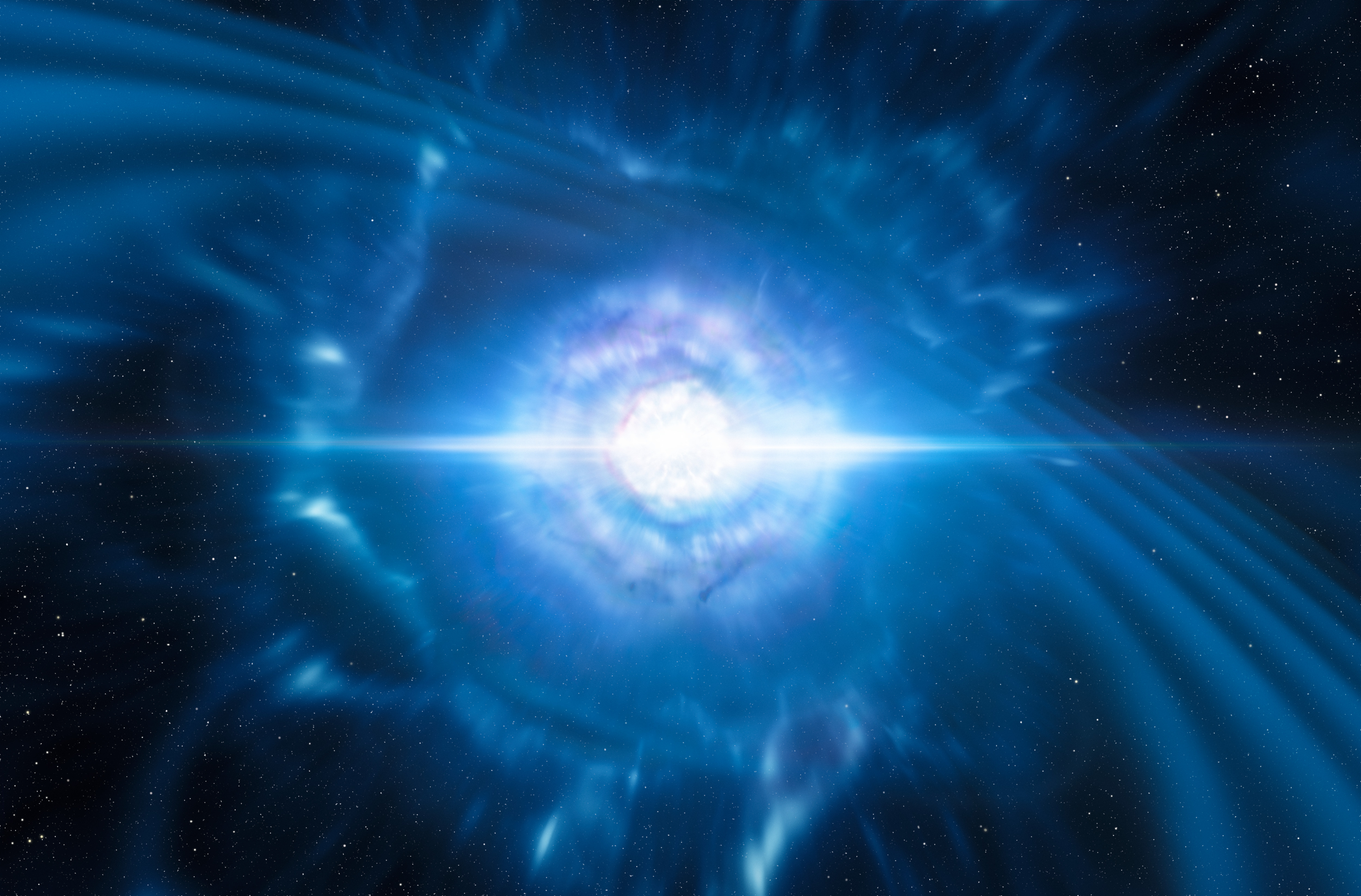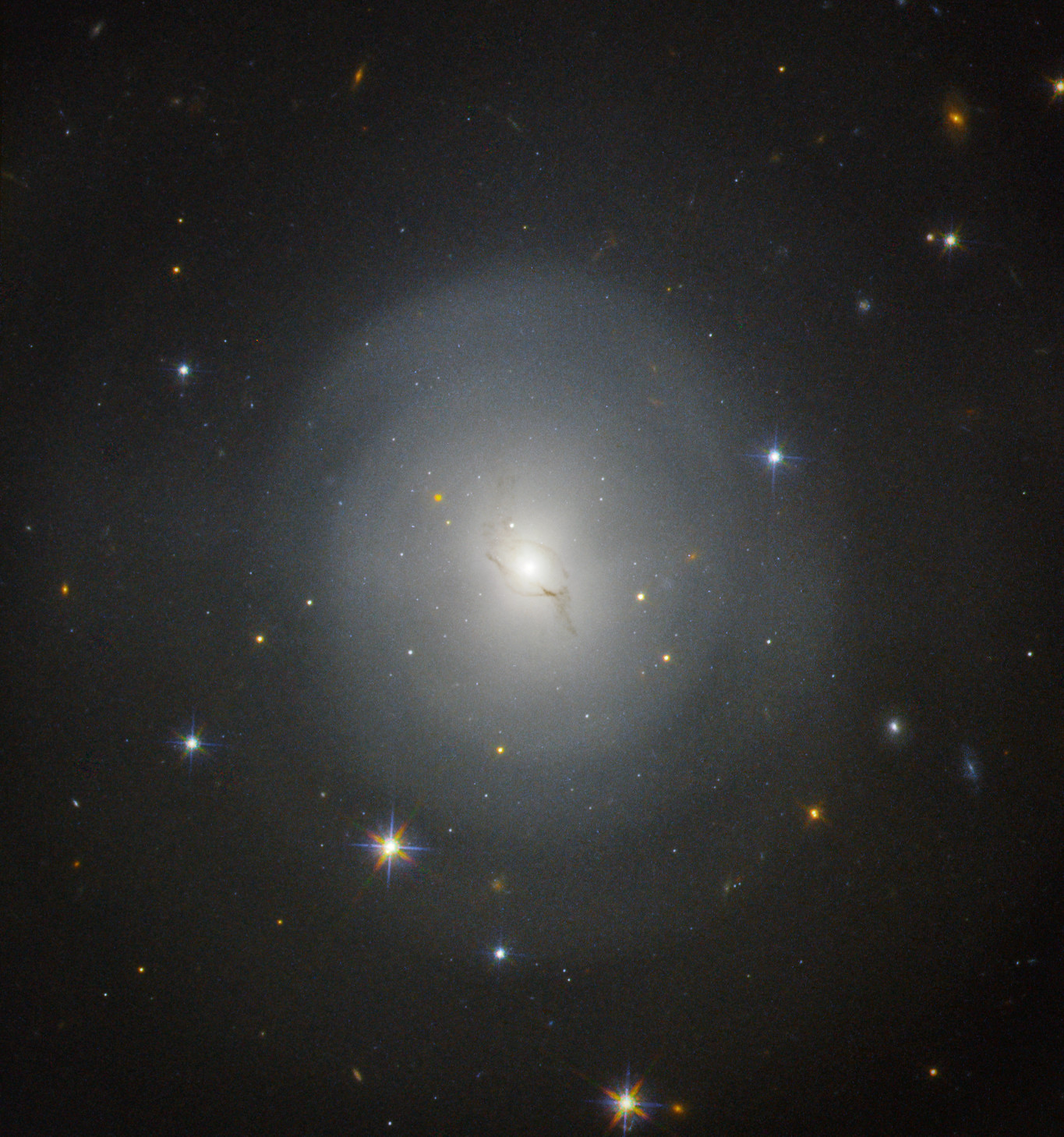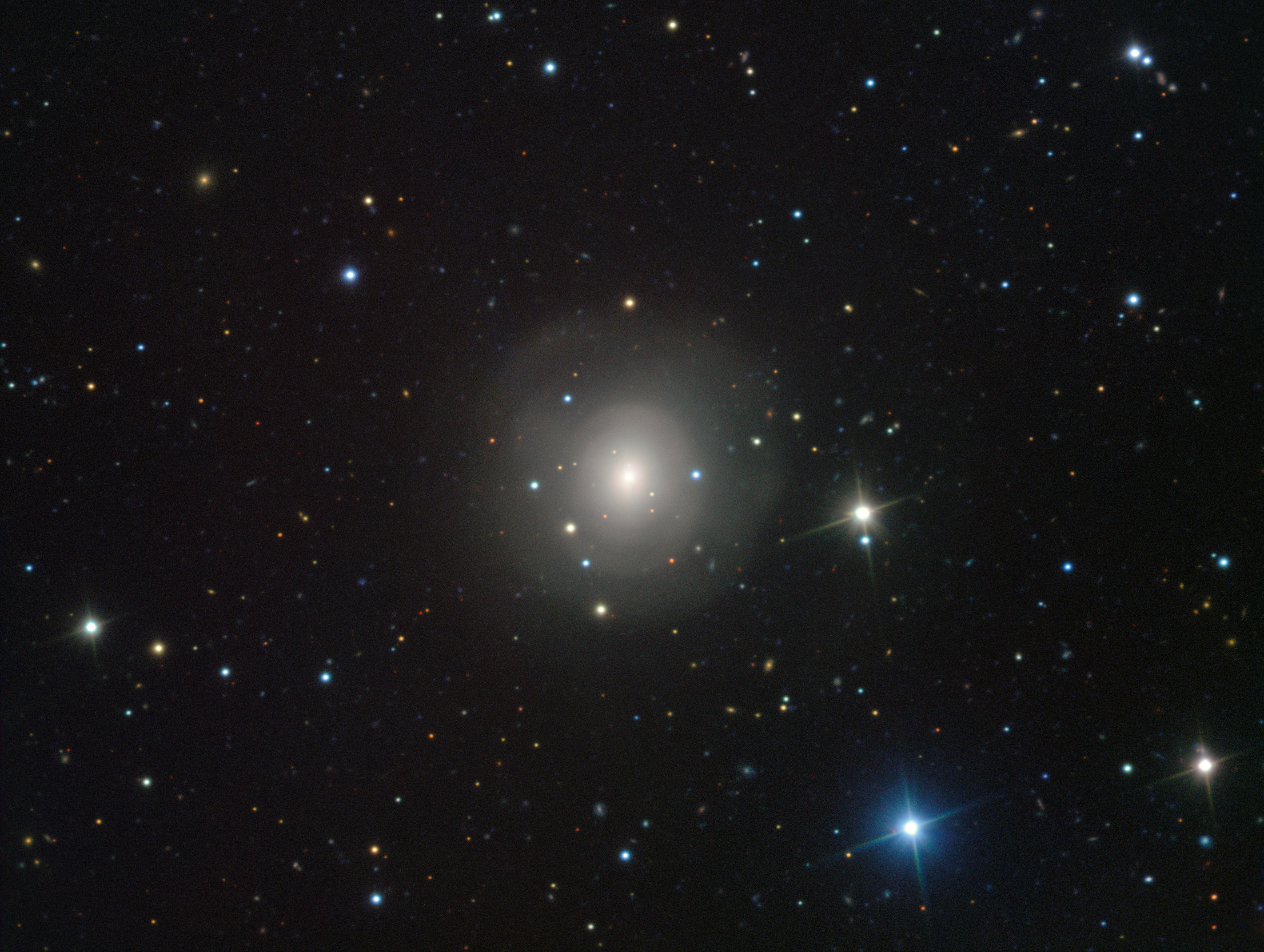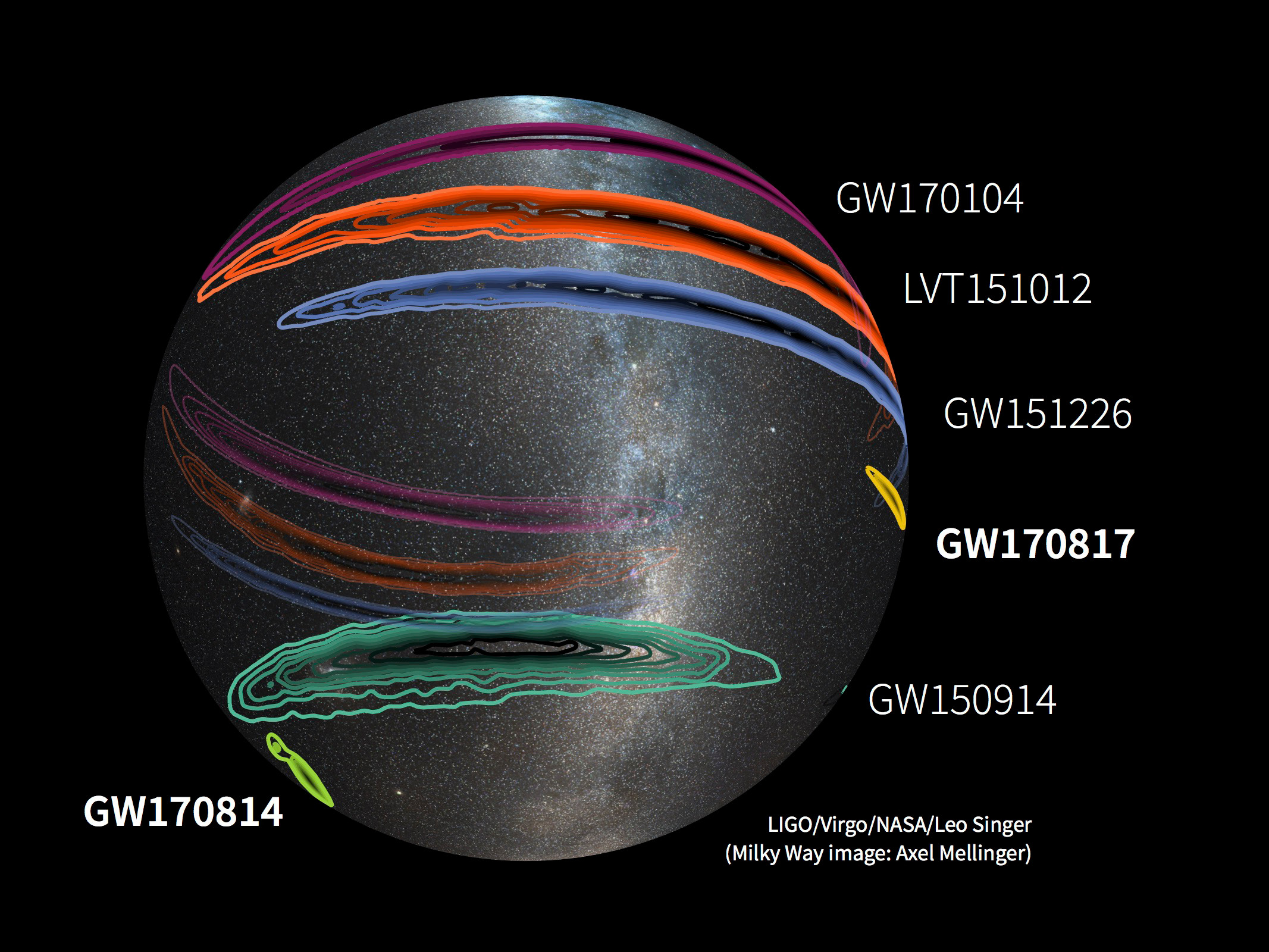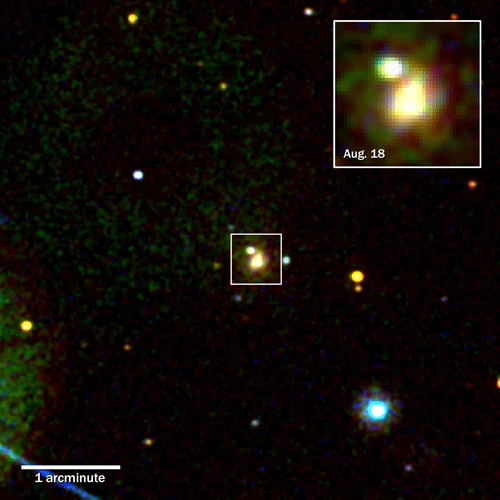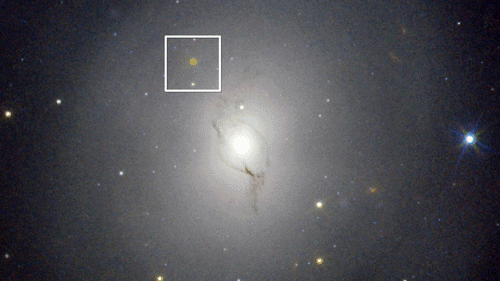First Glimpse of Colliding Neutron Stars Yields Stunning Pics
Telescopes all over the world and in space were busy on Aug. 17, when scientists made the first-ever observations of both light and gravitational waves from a single cosmic event. Here are some of the stunning images of the event, including some from the Hubble Space Telescope, as well as artists' illustrations that give insight into the complex workings of this energetic collision.
The eruption of light and gravitational waves (ripples in the universal fabric known as space-time) was produced by an event known as a kilonova, or the collision and merger of two neutron stars, which are the dead cores of stars that stopped burning fuel. This is the first time scientists have directly observed a kilonova eruption, scientists said during a news conference today (Oct. 16).
Astronomers at today's news conference said that this detection of both light and gravitational waves marks the beginning of the era of multimessenger astrophysics, which means studying the cosmos with fundamentally different types of information, such as gravitational waves and light. [Gravitational Waves from Neutron Stars: The Discovery Explained]
Dozens of observatories detected the event using every wavelength of light, from radio waves to gamma-rays. The event was observed in gravitational waves by the Laser Interferometer Gravitational-Wave Observatory (LIGO), which has two detectors located in the U.S., and the Virgo gravitational-wave observatory in Italy.
Gravitational waves, first detected by LIGO in 2015, are produced by the acceleration of gigantic objects in the universe (such as colliding black holes or neutron stars).
Neutron stars merging
Neutron stars are the leftover, dense cores of larger stars that ended their lives in supernova explosions. When two neutron stars merge, they can explode as a kilonova, as shown in this artist's impression. While kilonovas are believed to be rare, the observations confirm that these objects also produce heavy elements such as gold and platinum, including those found on Earth. Several observatories saw light from the event, in addition to the observations by LIGO and Virgo. All of the gravitational wave signals that LIGO has observed previously (and the one previous detection by Virgo) came from merging black holes. The object detected on Aug. 17 is in the galaxy NGC 4993 and is about 130 million light-years from Earth. [When Neutron Stars Collide! What Telescopes Saw (Videos)]
Flare of light
The kilonova explosion was spotted in the galaxy NGC 4993, which is shown here in an image from the Hubble Space Telescope. The kilonova is visible here to the upper left of the very bright galactic center, and appears as a golden-yellow spot. Astronomers have two names for the Aug. 17 event, depending on what type of phenomenon is referred to. GW170817 refers to the gravitational waves observed from the merger, while GRB 170817A looks at the gamma-ray burst produced by the neutron-star merger. Gamma-ray bursts are the brightest known electromagnetic events in the universe, and can be created by a few different phenomena.
Breaking space news, the latest updates on rocket launches, skywatching events and more!
Wide-angle view of NGC 4993
This wider view of NGC 4993 comes from the Visible MultiObject Spectrograph (VIMOS) on the European Southern Observatory's Very Large Telescope, located in the Atacama Desert in northern Chile. The kilonova explosion is also visible here — it is the small, white speck immediately above and to the left of the galaxy's center. (This image shows exactly where the kilonova is.) A statement from ESO describes the galaxy as "not itself unusual," even though it will go down in history as the home of the first observed kilonova. The galaxy was first discovered in 1789 by the astronomer William Herschel, and is in the constellation Hydra. Amateur observers can use telescopes to see the galaxy as a fuzzy object, which is located near galaxies M83 and M68.
Mapping gravitational wave sources
This map shows the locations of all five gravitational-wave signals detected by LIGO since the first detection in 2015. In the background is an optical image of the Milky Way; the discoveries are plotted on the entire celestial sphere, which is represented as a translucent dome. The gravitational waves come from relatively small sources (the two neutron stars were each only about the size of a large city), but LIGO cannot pinpoint the location of those sources: It can only provide scientists with a wide area from which the source originated. When the Virgo detector began detecting signals, however, and combined them with LIGO's two detectors, researchers were able narrow down this range somewhat. It is only with light-based telescopes that researchers were finally able to pinpoint the location of a gravitational-wave source on the sky. [In Videos: Gravitational-Wave Detection from Neutron-Star Crash]
Ultraviolet glow
The Aug. 17 kilonova was also visible in ultraviolet light, as spotted by NASA's Swift telescope. The Swift ultraviolet and optical telescope imaged the event about 15 hours after other observatories detected the gravitational waves and gamma-ray burst on Aug. 17. Just 12 days later, on Aug. 29, the kilonova faded and became undetectable in ultraviolet light. This image uses false colors and is based on data from images taken with three ultraviolet filters. Inset is a magnified view of the galaxy.
X-ray burst
This image combines optical observations by NASA's Hubble Space Telescope and X-ray observations from NASA's space-based Chandra X-ray Observatory. While Hubble saw optical and infrared light from hot debris associated with the kilonova, Chandra saw an X-ray afterglow on Aug. 26, nine days after the merger. The X-rays come from a jet of material and light directed toward Earth that was initially too narrow to be observable, but expanded and eventually became visible, according to NASA.
Extreme explosion
The kilonova on Aug. 17 was visible to several instruments on multiple telescopes that are all managed by the European Southern Observatory. Some of those observations are shown here in a composite image. Upper left: Observations from the OmegaCAM (a wide-field imager) on the Very Large Telescope array (VLT) Survey Telescope (VST). Upper right: The VISTA InfraRed CAMera (VIRCAM) on the VISTA (Visible and Infrared Survey Telescope for Astronomy). Lower left: The Gamma-ray Burst Optical/Near-infrared Detector (GROND) on the MPG/ESO 2.2-meter telescope. Lower right: The Visible MultiObject Spectrograph (VIMOS) on the VLT. Center: The Multi Unit Spectroscopic Explorer on the VLT.
Follow us @Spacedotcom, Facebook and Google+. Original article on Space.com.

Elizabeth Howell (she/her), Ph.D., was a staff writer in the spaceflight channel between 2022 and 2024 specializing in Canadian space news. She was contributing writer for Space.com for 10 years from 2012 to 2024. Elizabeth's reporting includes multiple exclusives with the White House, leading world coverage about a lost-and-found space tomato on the International Space Station, witnessing five human spaceflight launches on two continents, flying parabolic, working inside a spacesuit, and participating in a simulated Mars mission. Her latest book, "Why Am I Taller?" (ECW Press, 2022) is co-written with astronaut Dave Williams.
